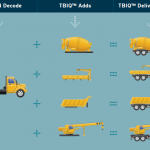Best Times to Buy and Sell Commercial Trucks at Auction
How to Interpret This Seasonality Data
For the purposes of this analysis, we are calculating seasonality as how far a particular month’s average pricing was from the average for the year. So, for example, January 2017 average pricing is compared against the overall 2017 average to determine the percentage difference. In this way we can compare multiple years’ worth of pricing seasonality without being bogged down by how much overall prices themselves were increasing or decreasing from year to year.
Pricing Seasonality for Heavy Duty Trucks
Below we can see auction price seasonality for heavy duty trucks from January 2017 through October 2021. For 2017 through 2020, each month’s average price is compared to the year’s average price and the percentage above or below is shown. For 2021, average pricing for the full year is based on data from January through October.
The first thing that stands out about this auction price seasonality is that it is quite volatile, with some months (January 2018 and March 2019, for example) showing deviations of more than 60% from the average for the full year. A key factor that may explain this wide range of deviations is the nature of auctions themselves. As timed events where, to a large degree, items for sale are going to be sold within a certain window, auctions introduce a sense of urgency for buyers and sellers and reflect the market dynamics for that particular month. This will be more volatile than if we were to look at resale list pricing where that sense of urgency is removed, and pricing tends to be more consistent from month-to-month.
Another aspect that drives volatility is the age of the vehicles being auctioned in a particular month. Prime examples include January 2017 and February 2018. In January 2017, pricing was 13.5% above average and average age was 17.1% below average. This inverse relationship between pricing and asset age worked in the other direction in February 2018, when vehicles at auction were quite a bit older than the average for the year (49.3%), sending pricing for the same month down (27.2% below the average for the year).
The next thing that stands out may be those months where we see many years going in a particular direction. For example, in most years January pricing is quite low compared to the rest of the year, while pricing in February for most years looks to be above average. This dynamic ties in closely with industry hype—particularly in relation to trucks involved in the construction industry—around mega auctions in February and expectations for higher-than-average prices. February and into March is also when many OEMs open up orders for new model years, so focus on updating fleets can be concentrated in these months. Strictly in terms of activity, however, we tend to see more activity coinciding with the end of the quarter (in March, June, September, and December) than specifically in relation to February auctions.
While there are few months with seasonality pointing in the same direction for all years tracked, we do see prices trending mostly below average over the summer months (June through August) before popping back up in September.
The two months not yet recorded in this analysis are November and December 2021. Looking at previous Novembers on the auction channel, we can see it has been a mixed bag, with pricing below average in 2017 and 2018 but above average in 2019 and 2020. December, on the other hand, has been the only month to see consistently below average pricing. This trend for December is likely influenced by many firms eager to sell off vehicles to meet end of year profit goals and hesitant to purchase any higher priced trucks until they have access to their budget for the new year. This also helps explain why we see an increase in auction activity in December despite the lower-than-average pricing.
About Price Digests
Since 1911 Price Digests has served the vehicle data needs of the insurance, finance, government, and dealer markets through its portfolio of VIN decoding, specifications, and market value data solutions for the commercial truck, passenger vehicle, marine, powersport, and recreational vehicle asset classes. Our data insights help enterprises drive competitive advantage through asset data workflow efficiencies while also playing a pivotal role in decisions surrounding the purchase, valuation, operation, and risk mitigation of assets. Price Digests data is powered by The Truck Blue Book.




